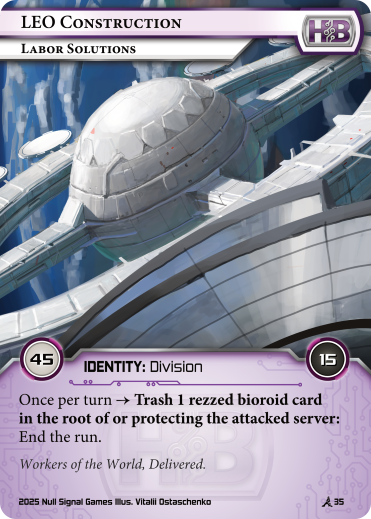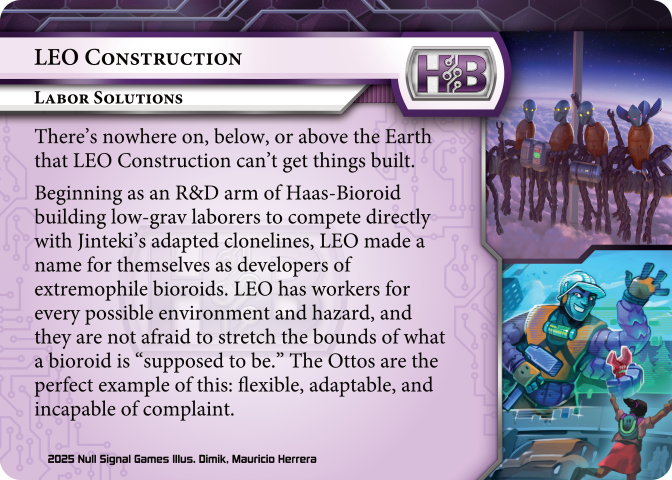Playtester Chronologist joins us to debut a new Haas-Bioroid identity and tell the tale of a new innovation that arose during Elevation playtesting.
Playtesting is a complicated process, in which we often need to pursue multiple conflicting priorities at the same time. Developers might want more feedback on some cards, while playtesters are concerned with other areas. Occasionally, this leads to some cards not getting much play at all, leaving developers without clear ideas about how they will perform.
For this article, I wanted to take the chance to highlight a story from playtesting I was not directly a part of. I sat down with Safer (he/him), the co-lead of the Development team, and Watzlav (he/they), a playtester, to have a conversation about one of the new Haas-Bioroid identities and one of the playtesting tools that helped bring it to life.
Playtest Bounties
During playtesting, playtesters would often discuss potentially concerning card interactions without having sufficient data on them. Developers, observing this, decided there needed to be a formalized way to reward playtesters for discovering these interactions, and help give playtesters direction on what development wanted data on.
As Safer said, “some of the new [dev team members], who joined during Elevation were like, ‘Can we do this?’ And the general sentiment across the team was ‘yeah, this seems like a good idea. Let’s do it.’”
And so, ‘Playtest Bounties’ were born.
Playtest bounties were designed to test out a specific interaction or combination of cards. A bounty might be phrased like “create a deck that consistently does X with Y cards”. Finding a broken interaction by completing a bounty is rewarded with inclusion in a ‘hall of fame’ in the playtest server (not to mention being responsible for a change or two to the cards in question).
As Watzlav said, this “feels a little bit like a dare to the playtesters. Like, ‘try to break it’. And there are some people who are really talented at deck building and trying to really abuse cards”. Those players eagerly took up the challenge. Sometimes, this was a bit more personal—as Watzlav recalls, sometimes he would approach one of the playtest bounties “with a very clear agenda. I was trying to prove that this is unfun and broken.”
For developers, these bounties are a stress test for a card interaction, giving more confidence in how the designs play out, and helping developers align with playtesters.
As Safer said, “[bounties] give us the confidence to make better informed decisions on very specific things that we just wouldn’t get if it wasn’t for people focusing so specifically on trying to break cards and their interactions in a specific manner.”
He shared an anecdote with a bounty for the card Shred, which he himself did not see as problematic at the time, but which some playtesters were very insistent was unhealthy for the game: “I didn’t have the same read on it that they did. Every time that I saw it in a replay […] it was inconclusive to me. So, let’s put a bounty to it. And over the course of that bounty, seeing all the replays that were submitted—basically getting more data on it, it was like, oh yeah, no, we’re starting to see the pattern, like all of the time.”
And so the bounty was awarded to ManintheMoon, Santa, and Zarg0n, whose combined effort showed the card’s problems clearly. And Shred was changed. But we’re not here to talk about Shred—we’re here to talk about a new identity which had a much more unusual bounty placed on it.
Biotic Labor
Haas-Bioroid have always been associated with bioroids, and printing an HB identity that interacted with bioroid cards in Elevation was one of the Design team’s goals. Furthermore, with identities like Architects of Tomorrow rotating, there was a gap in the format for a glacier-focused ID. However, the Design team were interested in exploring new directions for bioroids, and so, LEO Construction came to be:
While this card in its final form is close to its original design, the road there was not as straightforward, as it proved a challenge to properly playtest its efficacy. With only four bioroid ice left in the new cardpool before Elevation, and an identity this dependent on access to bioroids, it was difficult to get the full sense of the potential power level of LEO Construction.
And so, the developers offered up a unique bounty for playtesters:
Playtest LEO Construction, using all bioroids ever printed*.
*Except Fairchild 3.0
This gave a controlled environment that would simulate how LEO would operate in a future scenario with many more bioroids than exist today, allowing potential power level issues and future design space constrictions to be spotted during testing.
What did we learn?
“The thing that I learned was how emotionally attached players are to bioroids”, Safer said. He meant this in two senses: not only are players really fond of the old (rotated and rotating) bioroid cards, but, in a more literal sense, players are hesitant to trash their installed cards.
Watzlav seconded this: “I was also hesitant [to trash my ice] at first, but then once I tried it, I realized it’s just an emotional thing. Like, Brân is the best piece of ice on the board right now. I can’t use it [for LEO’s ability]. But then if you just compare it with a M.I.C. or Border Control, M.I.C. is literally the same amount of money for a worse effect.”
For a time in testing, LEO gave 1-2 credits when you used its ability, which as Safer highlighted was “almost like a psychological trick” encouraging players to use it. This helped make players enjoy using it more, but also made the identity more powerful in combination with cheap bioroids.
A potential issue with LEO Construction was how it might constrict the design space of new bioroids. Safer compared it to NBN: Reality Plus, an identity that did not initially seem to restrict the design space of tags, yet due to its strength and flexibility turned out to be suffocating.
During this bounty testing, the concern that this extra economy might prove to be restrictive to bioroid design space in the future led to the only change to emerge from testing this bounty: the removal of the credit gain. Without this, the future design space of bioroids was not as much of a concern, although, of course, as Safer acknowledged, “we’re never going to really know until it’s out in the wild.”
Watzlav brought up one potential restriction on future design: bioroid upgrades. Safer agreed, but added some historical context: “We think of Ash and how impactful that was and we think ‘oh man bioroid upgrades are so good’. Well, there’s Ash, there’s Warroid Tracker… and then there’s Isaac Liberdade from Rebellion Without Rehearsal. And that’s it. Those are the only bioroid upgrades that have been printed.” So while that space is restricted, it was never a large space to begin with.
Despite this, the bounty hunters did not prove that LEO Construction was too powerful, and so in the end, the bounty was not awarded to anyone. Yet, along the way, we glimpsed the potential future of the HB cardpool with this identity card in it, and learned that trashing our own cards might, sometimes, be a good idea. As Watzlav argued: “LEO introduces this interesting, changing board state. And it keeps it from getting out of hand.”
It is an abnormal HB identity, one that asks players to continuously reevaluate the worth of their bioroids. It is a glacier identity, yet not one that is likely to build servers tall enough to infringe on your opponent’s playmat every game. It is a card that caused the most unique use of the bounty system to date.
To end, I will share an anecdote from Safer from one of his playtest games:
It’s late in the game. Safer has a Brân on R&D. The Runner goes in for a single access. “[I knew] I should use the Brân. [But] I was like… ‘it’s a single from R&D. It doesn’t matter. It’s fine…’ But I was pretty confident the ‘correct play’ was to stop the single access. And then they hit an agenda, and played Reprise and the game was lost from there.”
Lesson learned: trash your Brâns, kids.
Join us in Kota Kalimantan when Elevation releases on April 24th 2025!


